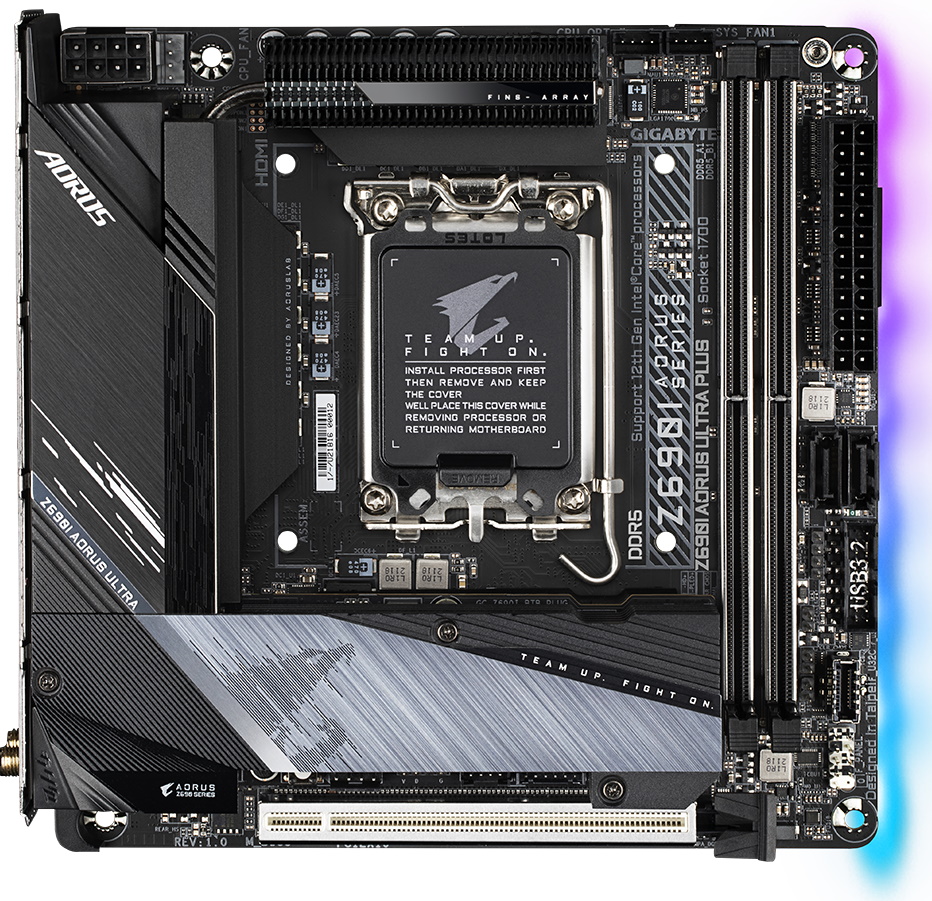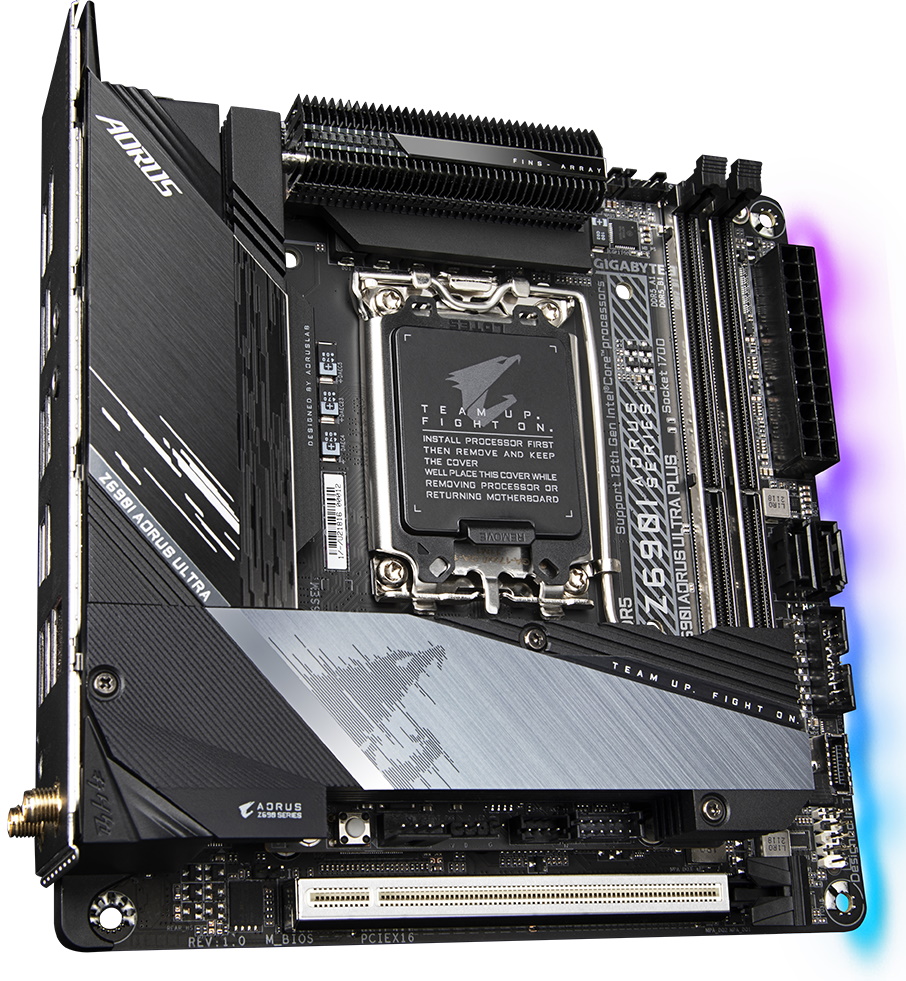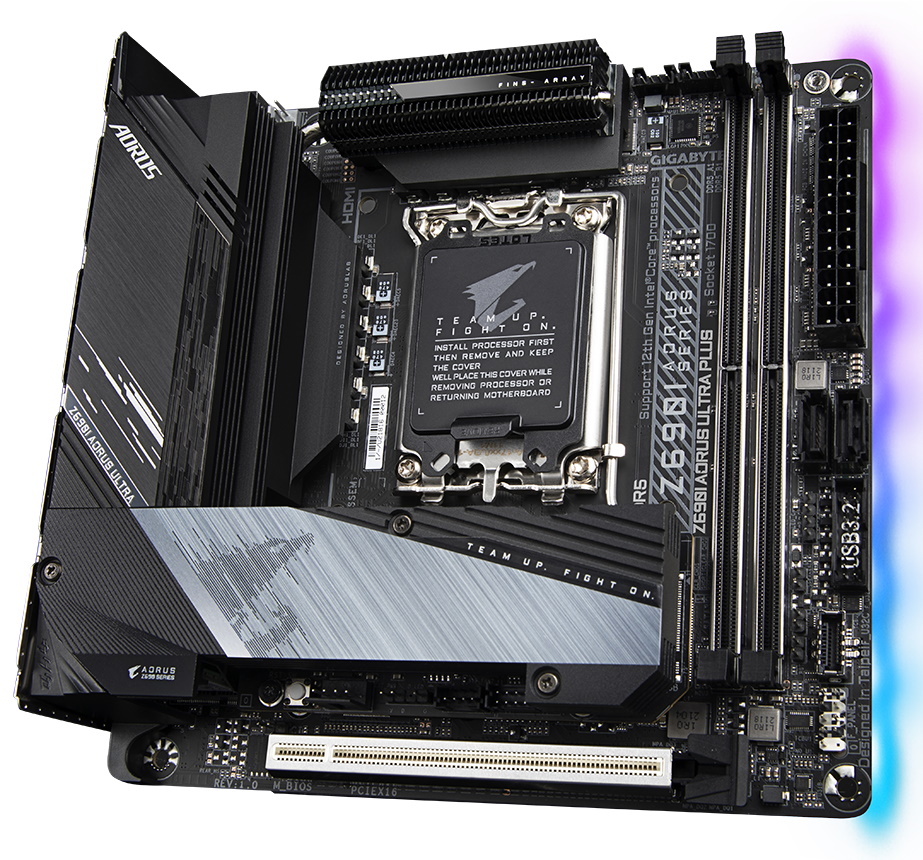Tom's Hardware Verdict
Priced at $329.99, the Z690I Aorus Ultra Plus is well-priced and generally well equipped for a Mini-ITX board. It looks good, has integrated RGB, and is arguably the best option in the Z690 Mini-ITX space. But if you need more than two SATA ports, you’ll need to look at other options.
Pros
- +
Low price among ITX Z690 peers
- +
Premium appearance includes RGB LEDs
- +
Robust 105A SPS MOSFETs
Cons
- -
Only two SATA ports
- -
No SATA M.2 support
Why you can trust Tom's Hardware
New for the summer of 2022, the Z690I Aorus Ultra Plus is a Mini-ITX update of the Aorus Ultra. If you remember, Gigabyte confirmed stability issues on that board when running the PCIe slot at the full PCIe 4.0 bandwidth. So the company issued an exchange/refund program and offered a workaround by lowering the PCIe bandwidth to 3.0 speeds. The old board is now the Aorus Ultra Lite and is limited to PCIe 3.0 x16, while the Z690I Aorus Ultra Plus offers the full PCIe 4.0 x16 bandwidth.
History aside, you’ll find the updated board on Newegg and Amazon for $329.99, boasting the same hardware as the original/Ultra Lite (which isn’t a bad deal now at $150.99). The Ultra Plus has robust power delivery, including 105A SPS MOSFETs, a premium audio codec, two M.2 sockets (none are PCIe 5.0, sadly), fast networking with integrated Wi-Fi 6E and a 2.5 GbE port. It also looks good and is the only Z690 Mini-ITX board that includes onboard RGB lighting. Hardware-wise, it’s well-equipped and sits on the lower end of the Z690 Mini-ITX price range. making it an attractive option for those looking to build a small PC.
The board’s performance across our test suite was average to above average, with nothing notably slow or fast. Power use and memory bandwidth were spot on, as was its tested performance in games. The good news is that we didn’t notice any instability running default/PCIe 4.0 or capture any WHEA errors in our time with the board. It looks like Gigabyte’s update fixed the issue with the board and locked down the previous version to ensure stability on the existing models.
We’ll look at the board’s full list of features and performance below and determine if it carves out a spot on our best motherboards list. Read on to get all the information you need to make an informed buying decision. Before that, here’s a list of specs, directly from Gigabyte’s website.
Specifications: Gigabyte Z690I Aorus Ultra Plus
| Socket | LGA1700 |
| Chipset | Z690 |
| Form Factor | Mini-ITX |
| Voltage Regulator | 13 Phase (10+1+2, 105A SPS MOSFETs for Vcore) |
| Video Ports | (1) HDMI (v2.0) |
| Row 5 - Cell 0 | (1) DisplayPort (v1.4) |
| USB Ports | (1) USB 3.2 Gen 2x2 Type-C (20 Gbps) |
| Row 7 - Cell 0 | (3) USB 3.2 Gen 2 (10 Gbps) |
| Row 8 - Cell 0 | (2) USB 3.2 Gen 1 (5 Gbps) |
| Row 9 - Cell 0 | (2) USB 2.0 (480 Mbps) |
| Network Jacks | (1) 2.5 GbE |
| Audio Jacks | (2) Analog + SPDIF |
| Legacy Ports/Jacks | ✗ |
| Other Ports/Jack | ✗ |
| PCIe x16 | (1) v5.0 (x16) |
| PCIe x8 | ✗ |
| PCIe x4 | ✗ |
| PCIe x1 | ✗ |
| DIMM Slots | (2) DDR5 6400+(OC), 64GB Capacity |
| M.2 Sockets | (2) PCIe 4.0 x4 (64 Gbps) / PCIe (up to 80mm) |
| U.2 Ports | ✗ |
| SATA Ports | (2) SATA3 6 Gbps (Supports RAID 0/1) |
| USB Headers | (1) USB v3.2 Gen 1, Type-C (5 Gbps) |
| Row 23 - Cell 0 | (1) USB v3.2 Gen 1 (5 Gbps) |
| Row 24 - Cell 0 | (1) USB v2.0 (480 Mbps) |
| Fan/Pump Headers | (3) 4-Pin (CPU, Watercooling CPU, System Fan) |
| RGB Headers | (1) aRGB (3-pin) |
| Row 27 - Cell 0 | (1) AURA RGB (4-pin) |
| Diagnostics Panel | ✗ |
| Internal Button/Switch | ✗ |
| SATA Controllers | ✗ |
| Ethernet Controller(s) | Intel I225-V (2.5 Gbps) |
| Wi-Fi / Bluetooth | Intel AX411 Wi-Fi 6E (2x2 ax, MU-MIMO, 2.4/5/6 GHz, 160 MHz, BT 5.2) |
| USB Controllers | ✗ |
| HD Audio Codec | Realtek ALC4080 |
| DDL/DTS | ✗ / DTS:X Ultra |
| Warranty | 3 Years |
Inside the Box of the Gigabyte Z690I Aorus Ultra Plus
Gigagbyte includes several accessories along with the board. The basics are all there, including multiple fan header adapters (a couple of the 4-pin headers are not the standard size), a USB 2.0 header (same as the USB ports, a non-standard header to save on board real estate), SATA cables, and more. Again, my Gigabyte sample did not include a driver disk/USB. If yours arrives without, get the latest drivers from Gigabyte’s site. Here’s a list of the included extras.
- (2) SATA 6Gb/s cables
- (3) 4-pin to 4-pin fan adapters
- RGB extension cable
- USB extension cable
- 4-pin to Molex cable
- Wi-Fi antennas
- M.2 SSD screw packages
- User manual
Design of the Z690I Aorus Ultra Plus



Looking at the Z690I Aorus Ultra Plus, we get a good sense of the general styling. Like its larger siblings, the board sports a black PCB with a brushed-aluminum finish on the black heatsinks, along with a gray accent proudly showing off the Aorus falcon[1] . All sockets are reinforced and there’s a backplate that protects the back of the board and (presumably) helps with thermals. Along the right edge of the board is a row of several RGBs that produce a bright glow with saturated colors. Despite its small size, this is a good-looking board to build your Alder Lake-based system around, especially if you’re looking for RGB lighting without having to supply strips or other accessories.
With larger boards, we split the feature discussion into halves. But since there isn’t a distinct top and bottom here, we’ll cover the features moving clockwise around the board. On the left, the VRM heatsink sports the Aorus branding in white, with the board's name toward the bottom. On top is a required 8-pin EPS to power the CPU, while next to it is one of four fan headers (one of two full-size 4-pin headers). The heatsinks seem to have plenty of mass and surface area to keep the beefy power delivery below easily running within spec.
Get Tom's Hardware's best news and in-depth reviews, straight to your inbox.
Moving right, past the top VRM bank, we run into two more 4-pin fan headers. However, these are smaller and proprietary, to save space. So they require the included 4-pin to 4-pin adapters to fit standard fan connectors. Each header supports PWM and DC fans, with output up to 2A/24W. And they are controlled through the BIOS. Unless you have some massive pump or industrial fans, the output here should be plenty to support air or water cooling configurations.

Power delivery on our little Aorus Ultra Plus is one of the more robust we’ve seen on an ITX board for this generation, and is plenty to overclock our Intel Core i9-12900K or even the flagship i9-12900KS. Power flows from the required 8-pin EPS connector, on to a Renesas RAA229130 controller and then on to the 10 105A Renesas RAA22010540 SPS MOSFETs. The corresponding 1,050A available won’t hold your overclocking adventures back and is the same as supplied by the MSI Z690I Unify and Asus ROG Strix Z690I’s power deliveries.
Continuing right, we run into two reinforced DRAM slots with latching mechanisms on both sides. Gigabyte lists support for 64GB at speeds up to DDR4 6400(OC). The board ran both our kits (DDR5-5600 and DDR5-6000) without issue. Being an ITX board, we suspect there’s a lot more headroom available, but your mileage may vary depending on the memory kit and how good the CPU’s memory controller is.
Working our way down the right edge, we spy the 24-pin ATX connector to power the board, plus two SATA ports (supporting RAID0/1). The SATA port count will be low for some users, especially since the M.2 sockets only support PCIe-based M.2 modules, but as this is a board for compact systems, it should suffice for most people. Below are two USB headers: a Gen 2 (10 Gbps) Type-C and Gen 1 (5 Gbps) Type-A. Also in this area is a 4-pin RGB header for additional RGB lighting, while just below that is the front panel header.
Along the bottom edge is the full-length reinforced PCIe 4.0 x16 slot, and it indeed works at PCIe 4.0! The exposed audio codec (Realtek ALC4080) and a couple of Chemicon brand audio caps are to the left. The audio section here is solid, using a modern premium codec like most other Z690 ITX boards. Also in this area is the front-panel audio header (white).
Above the PCIe 4.0 slot is where you’ll find the other RGB header (3-pin), and a full-size 4-pin fan header. Mixed in this stack are the two M.2 sockets as well. Both M.2 sockets support up to 80mm PCIe/NVMe modules that run up to PCIe 4.0. You'll have to look elsewhere if you need SATA support from these sockets.

The rear IO area sports a pre-installed IO plate matching the Aorus theme (black and gray). The black background gives way to Aorus branding and labels for the ports in a dark gray. While it’s nice these are labeled, the dark gray doesn’t contrast as much as white, so the legends are difficult to read, especially in low-light situations.
In total, there are eight USB ports: One USB 3.2 Gen 2x2 (20 Gbps) Type-C, three USB 3.2 Gen 2 (10 Gbps/red), two USB 3.2 Gen 1 (5 Gbps/blue) ports, and two USB 2.0 (480 Mbps/black) ports. Seven Type-A ports should be enough for most users–especially those building a compact PC. Video outputs for the iGPU consist of one HDMI (v2.1) and one DisplayPort (v1.4). You’ll also find the Intel-based 2.5 GbE port and the Wi-Fi 6E antenna connections here. To access the Q-Flash functionality (BIOS flashing without a CPU), there’s a tiny button between the Wi-Fi connections and the red USB ports. Last here is the audio stack, consisting of two analog plugs (line out and mic). I would like to see the full 5-plug plus SPDIF here, but it’s not a dealbreaker for most these days.
MORE: Best Motherboards
MORE: How To Choose A Motherboard
MORE: All Motherboard Content

Joe Shields is a staff writer at Tom’s Hardware. He reviews motherboards and PC components.
-
mdd1963 Cons: no SATA M.2 support?Reply
That's a bit of a stretch; who would waste an NVME/SATA M.2 slot with a SATA drive anyway...